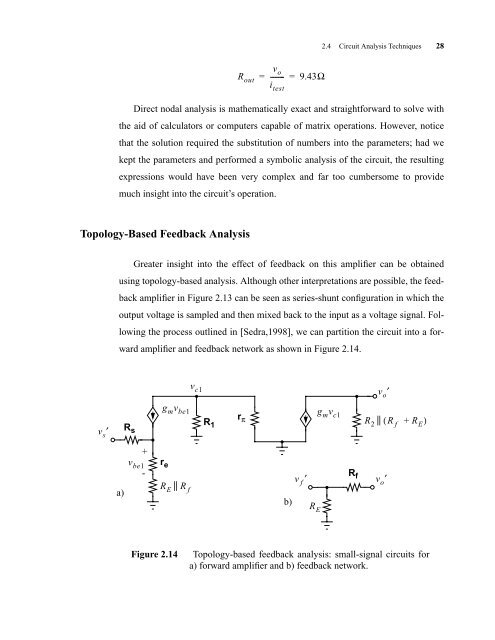CMOS Optical Preamplifier Design Using Graphical Circuit Analysis
CMOS Optical Preamplifier Design Using Graphical Circuit Analysis
CMOS Optical Preamplifier Design Using Graphical Circuit Analysis
You also want an ePaper? Increase the reach of your titles
YUMPU automatically turns print PDFs into web optimized ePapers that Google loves.
2.4 <strong>Circuit</strong> <strong>Analysis</strong> Techniques 28<br />
Direct nodal analysis is mathematically exact and straightforward to solve with<br />
the aid of calculators or computers capable of matrix operations. However, notice<br />
that the solution required the substitution of numbers into the parameters; had we<br />
kept the parameters and performed a symbolic analysis of the circuit, the resulting<br />
expressions would have been very complex and far too cumbersome to provide<br />
much insight into the circuit’s operation.<br />
Topology-Based Feedback <strong>Analysis</strong><br />
v s ′<br />
R out<br />
Greater insight into the effect of feedback on this amplifier can be obtained<br />
using topology-based analysis. Although other interpretations are possible, the feed-<br />
back amplifier in Figure 2.13 can be seen as series-shunt configuration in which the<br />
output voltage is sampled and then mixed back to the input as a voltage signal. Fol-<br />
lowing the process outlined in [Sedra,1998], we can partition the circuit into a for-<br />
ward amplifier and feedback network as shown in Figure 2.14.<br />
a)<br />
R s<br />
v be1<br />
+<br />
-<br />
g m v be1<br />
r e<br />
R ||<br />
E R f<br />
v c1<br />
R 1<br />
r π<br />
v o<br />
= -------- = 9.43Ω<br />
i test<br />
g m v c1<br />
v o ′<br />
R || 2 ( R f + RE) Figure 2.14 Topology-based feedback analysis: small-signal circuits for<br />
a) forward amplifier and b) feedback network.<br />
b)<br />
v f ′<br />
R E<br />
R f<br />
v o ′














